2019 Hyundai Tucson Sport
[x] Cancel search: SportPage 399 of 685
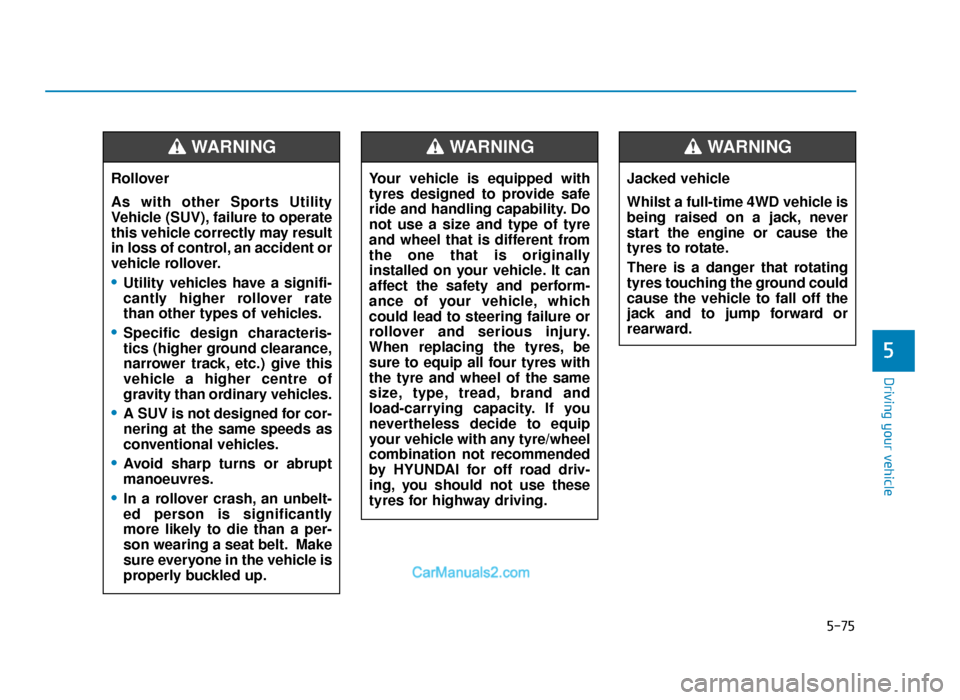
5-75
Driving your vehicle
5
Rollover
As with other Sports Utility
Vehicle (SUV), failure to operate
this vehicle correctly may result
in loss of control, an accident or
vehicle rollover.
•Utility vehicles have a signifi-
cantly higher rollover rate
than other types of vehicles.
•Specific design characteris-
tics (higher ground clearance,
narrower track, etc.) give this
vehicle a higher centre of
gravity than ordinary vehicles.
•A SUV is not designed for cor-
nering at the same speeds as
conventional vehicles.
•Avoid sharp turns or abrupt
manoeuvres.
•In a rollover crash, an unbelt-
ed person is significantly
more likely to die than a per-
son wearing a seat belt. Make
sure everyone in the vehicle is
properly buckled up.
WARNING
Your vehicle is equipped with
tyres designed to provide safe
ride and handling capability. Do
not use a size and type of tyre
and wheel that is different from
the one that is originally
installed on your vehicle. It can
affect the safety and perform-
ance of your vehicle, which
could lead to steering failure or
rollover and serious injury.
When replacing the tyres, be
sure to equip all four tyres with
the tyre and wheel of the same
size, type, tread, brand and
load-carrying capacity. If you
nevertheless decide to equip
your vehicle with any tyre/wheel
combination not recommended
by HYUNDAI for off road driv-
ing, you should not use these
tyres for highway driving.
WARNING
Jacked vehicle
Whilst a full-time 4WD vehicle is
being raised on a jack, never
start the engine or cause the
tyres to rotate.
There is a danger that rotating
tyres touching the ground could
cause the vehicle to fall off the
jack and to jump forward or
rearward.
WARNING
TLe UK 5.qxp 5/10/2018 12:23 PM Page 75
Page 407 of 685
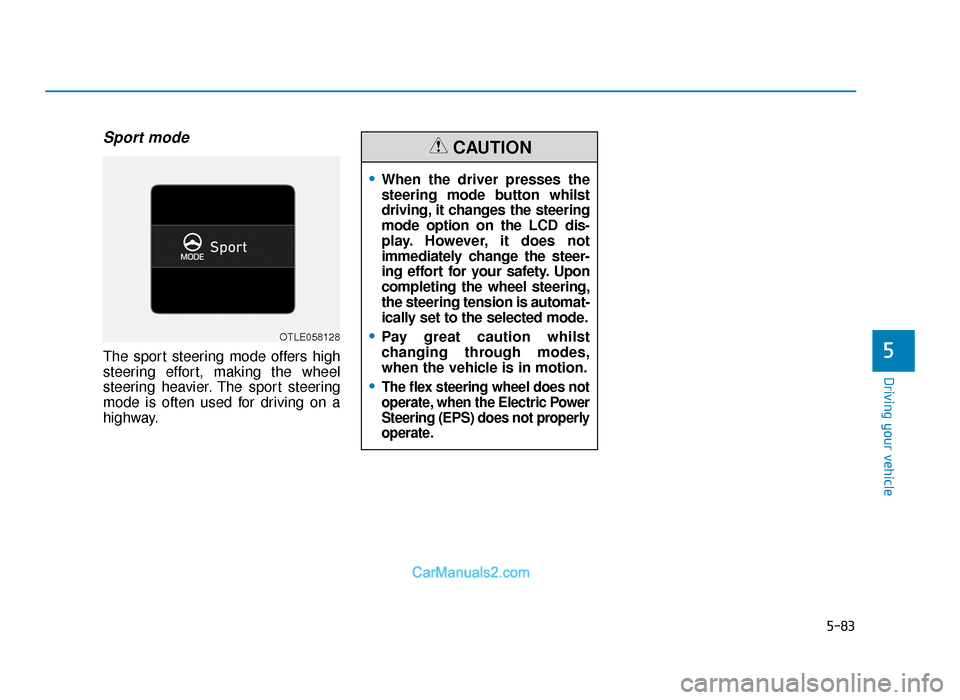
5-83
Driving your vehicle
5
Sport mode
The sport steering mode offers high
steering effort, making the wheel
steering heavier. The sport steering
mode is often used for driving on a
highway.
•When the driver presses the
steering mode button whilst
driving, it changes the steering
mode option on the LCD dis-
play. However, it does not
immediately change the steer-
ing effort for your safety. Upon
completing the wheel steering,
the steering tension is automat-
ically set to the selected mode.
•Pay great caution whilst
changing through modes,
when the vehicle is in motion.
•The flex steering wheel does not
operate, when the Electric Power
Steering (EPS) does not properly
operate.
CAUTION
OTLE058128
TLe UK 5.qxp 5/10/2018 12:24 PM Page 83
Page 408 of 685

5-84
Driving your vehicle
DRIVE MODE INTEGRATED CONTROL SYSTEM (IF EQUIPPED)
The drive mode may be selected
according to the driver's preference
or road condition.
The system resets to be in the COM-
FORT mode, when the engine is
restarted.
Information
If there is a problem with the instru-
ment cluster, the drive mode will be in
COMFORT mode and may not
change to SPORT mode. The mode changes, as below,
whenever the DRIVE MODE button
is pressed.
When COMFORT mode is selected,
it is not displayed on the instrument
cluster.
SPORT mode
SPORT mode manages
the driving dynamics by
automatically adjusting the
steering wheel, engine
and transaxle system.
• When the SPORT mode is select- ed by pressing the DRIVE MODE
button, the SPORT indicator (yel-
low colour) will illuminate.
• Restarting of the engine in the SPORT mode resets the DRIVE
mode to the COMFORT mode.
Thus, when necessary, reselect
the SPORT mode.
• When the SPORT mode is activated: - The RPM (revolutions per min-utes) level is maintained over a
certain length of time, even after
releasing the accelerator.
- Up-shifting timing is delayed, whilst accelerating.
Information
In the SPORT mode, the fuel efficiency
may decrease.
i
i
SPORT COMFORT
OTLE055130R
TLe UK 5.qxp 5/10/2018 12:24 PM Page 84
Page 431 of 685
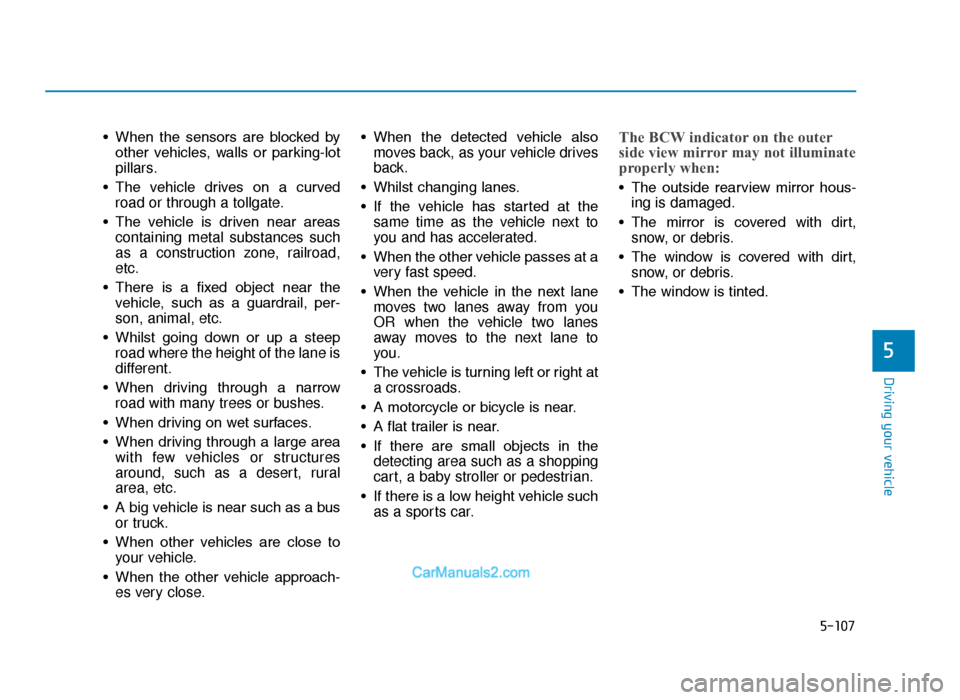
5-107
Driving your vehicle
5
• When the sensors are blocked byother vehicles, walls or parking-lot
pillars.
• The vehicle drives on a curved road or through a tollgate.
• The vehicle is driven near areas containing metal substances such
as a construction zone, railroad,
etc.
• There is a fixed object near the vehicle, such as a guardrail, per-
son, animal, etc.
• Whilst going down or up a steep road where the height of the lane is
different.
• When driving through a narrow road with many trees or bushes.
• When driving on wet surfaces.
• When driving through a large area with few vehicles or structures
around, such as a desert, rural
area, etc.
• A big vehicle is near such as a bus or truck.
• When other vehicles are close to your vehicle.
• When the other vehicle approach- es very close. • When the detected vehicle also
moves back, as your vehicle drives
back.
• Whilst changing lanes.
• If the vehicle has started at the same time as the vehicle next to
you and has accelerated.
• When the other vehicle passes at a very fast speed.
• When the vehicle in the next lane moves two lanes away from you
OR when the vehicle two lanes
away moves to the next lane to
you.
• The vehicle is turning left or right at a crossroads.
• A motorcycle or bicycle is near.
• A flat trailer is near.
• If there are small objects in the detecting area such as a shopping
cart, a baby stroller or pedestrian.
• If there is a low height vehicle such as a sports car.The BCW indicator on the outer
side view mirror may not illuminate
properly when:
• The outside rearview mirror hous-ing is damaged.
• The mirror is covered with dirt, snow, or debris.
• The window is covered with dirt, snow, or debris.
• The window is tinted.
TLe UK 5.qxp 5/10/2018 12:26 PM Page 107
Page 458 of 685

5-134
Driving your vehicle
• Decreasing the vehicle speed lower than the memory speed by
12 mph (20 km/h).
• Decreasing the vehicle speed to less than approximately 20 mph
(30 km/h).
• The ESC (Electronic Stability Control) is operating.
• Downshifting to the 2nd gear in Sports Mode.
Information
Each of the above actions will cancel
Cruise Control operation (The set
speed on the instrument cluster will go
off), but only pressing the button
will turn the system off. If you wish to
resume Cruise Control operation,
push the lever up (RES+) located on
your steering wheel. You will return to
your previously preset speed, unless
the system was turned off using the
button.
To resume preset Cruisingspeed
Push the lever (1) up (RES+). If the
vehicle speed is over 20 mph (30
km/h), the vehicle will resume the
preset speed.
To turn Cruise Control off
• Press the button (the indi-
cator will go off).
• Turn the engine OFF.
i
OTLE055059
OTLE055057
TLe UK 5.qxp 5/10/2018 12:29 PM Page 134
Page 464 of 685

5-140
Driving your vehicle
• Pressing the CANCEL / O button located on the steering wheel.
• Pressing the CRUISE / button. Both the CRUISE indicator and the
SET indicator will turn OFF.
• Moving the shift lever into N (Neutral). (for automatic transaxle /
dual clutch transmission vehicle)
• Decreasing the vehicle speed lower than the speed by 12 mph
(20 km/h).
• Decreasing the vehicle speed to less than approximately 20 mph
(30 km/h).
• The ESC (Electronic Stability Control) is operating.
• Downshifting to the 2nd gear in Sports Mode.
Information
Each of the above actions will cancel
Cruise Control operation (The set
speed on the instrument cluster will go
off), but only pressing the CRUISE
button will turn the system off. If you
wish to resume Cruise Control opera-
tion, push the lever up (RES+) located
on your steering wheel. You will
return to your previously preset
speed, unless the system was turned
off using the CRUISE button.
To resume preset Cruisingspeed
Push the lever (1) up (RES+). If the
vehicle speed is over 20 mph (30
km/h), the vehicle will resume the
preset speed.
i
OTLE055052
■ Type A
■Type BOTL055102
TLe UK 5.qxp 5/10/2018 12:30 PM Page 140
Page 487 of 685
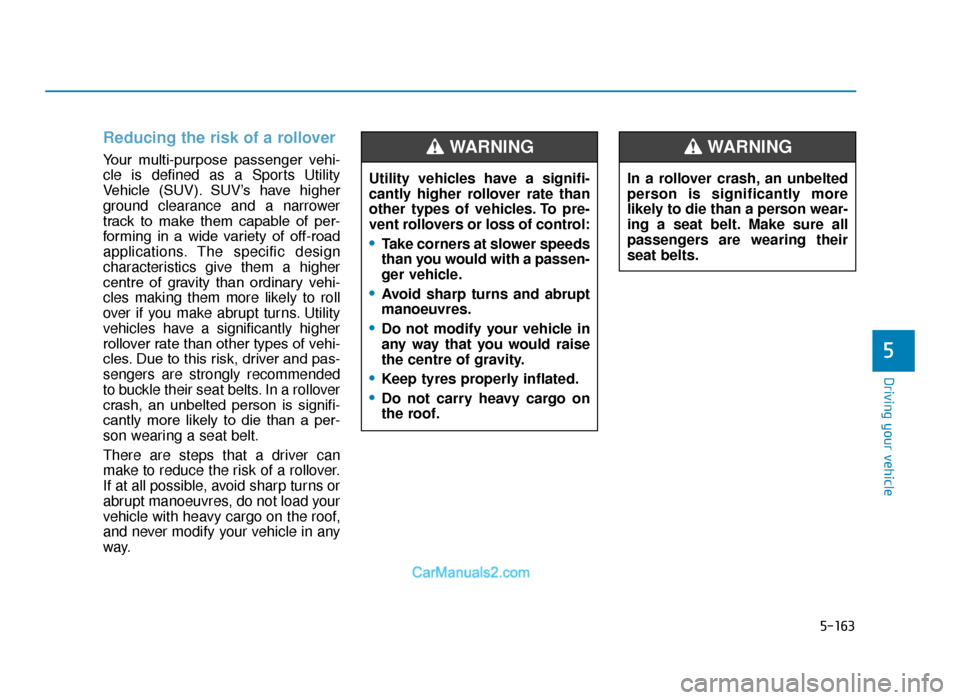
5-163
Driving your vehicle
5
Reducing the risk of a rollover
Your multi-purpose passenger vehi-
cle is defined as a Sports Utility
Vehicle (SUV). SUV’s have higher
ground clearance and a narrower
track to make them capable of per-
forming in a wide variety of off-road
applications. The specific design
characteristics give them a higher
centre of gravity than ordinary vehi-
cles making them more likely to roll
over if you make abrupt turns. Utility
vehicles have a significantly higher
rollover rate than other types of vehi-
cles. Due to this risk, driver and pas-
sengers are strongly recommended
to buckle their seat belts. In a rollover
crash, an unbelted person is signifi-
cantly more likely to die than a per-
son wearing a seat belt.
There are steps that a driver can
make to reduce the risk of a rollover.
If at all possible, avoid sharp turns or
abrupt manoeuvres, do not load your
vehicle with heavy cargo on the roof,
and never modify your vehicle in any
w a y.Utility vehicles have a signifi-
cantly higher rollover rate than
other types of vehicles. To pre-
vent rollovers or loss of control:
•Take corners at slower speeds
than you would with a passen-
ger vehicle.
•Avoid sharp turns and abrupt
manoeuvres.
•Do not modify your vehicle in
any way that you would raise
the centre of gravity.
•Keep tyres properly inflated.
•Do not carry heavy cargo on
the roof.
WARNING
In a rollover crash, an unbelted
person is significantly more
likely to die than a person wear-
ing a seat belt. Make sure all
passengers are wearing their
seat belts.
WARNING
TLe UK 5.qxp 5/10/2018 12:32 PM Page 163
Page 597 of 685
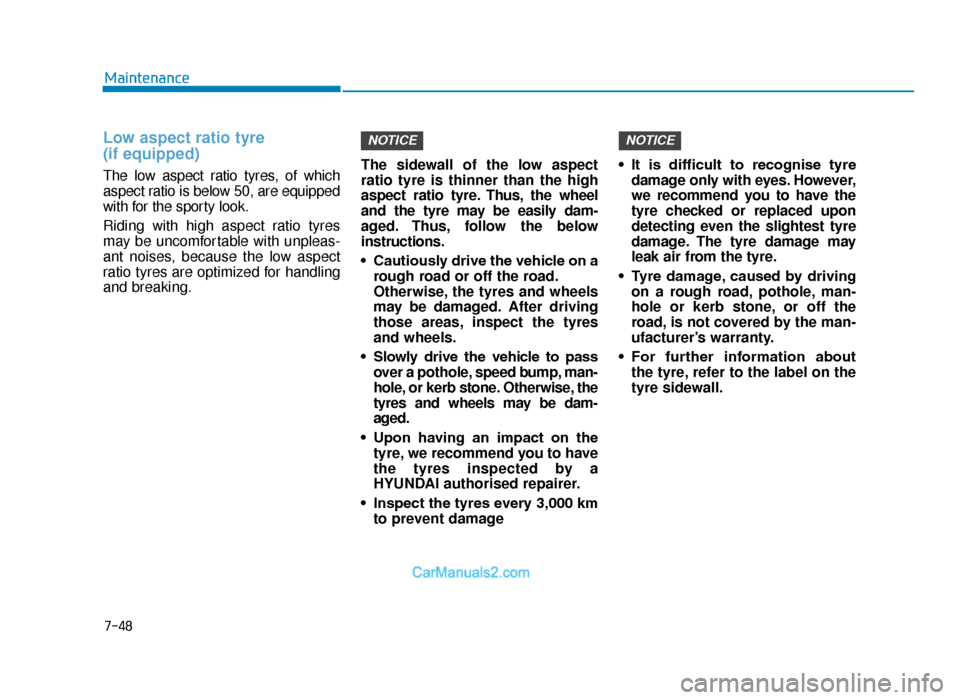
7-48
Maintenance
Low aspect ratio tyre
(if equipped)
The low aspect ratio tyres, of which
aspect ratio is below 50, are equipped
with for the sporty look.
Riding with high aspect ratio tyres
may be uncomfortable with unpleas-
ant noises, because the low aspect
ratio tyres are optimized for handling
and breaking.The sidewall of the low aspect
ratio tyre is thinner than the high
aspect ratio tyre. Thus, the wheel
and the tyre may be easily dam-
aged. Thus, follow the below
instructions.
• Cautiously drive the vehicle on a
rough road or off the road.
Otherwise, the tyres and wheels
may be damaged. After driving
those areas, inspect the tyres
and wheels.
• Slowly drive the vehicle to pass over a pothole, speed bump, man-
hole, or kerb stone. Otherwise, the
tyres and wheels may be dam-
aged.
• Upon having an impact on the tyre, we recommend you to have
the tyres inspected by a
HYUNDAI authorised repairer.
• Inspect the tyres every 3,000 km to prevent damage • It is difficult to recognise tyre
damage only with eyes. However,
we recommend you to have the
tyre checked or replaced upon
detecting even the slightest tyre
damage. The tyre damage may
leak air from the tyre.
• Tyre damage, caused by driving on a rough road, pothole, man-
hole or kerb stone, or off the
road, is not covered by the man-
ufacturer’s warranty.
• For further information about the tyre, refer to the label on the
tyre sidewall.
NOTICENOTICE
TLe UK 7.qxp 5/10/2018 1:35 PM Page 48